Themed collection CO2 Utilisation

Introduction to CO2 utilisation
Liang-Nian He and Da-Gang Yu introduce the themed collection on CO2 utilisation.
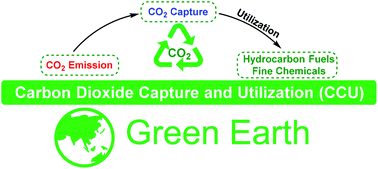
Green Chem., 2021,23, 3499-3501
https://doi.org/10.1039/D1GC90036F
CO2 hydrogenation over heterogeneous catalysts at atmospheric pressure: from electronic properties to product selectivity
The fundamental insights into the relationships among the electronic properties of active metals, the binding strengths of key intermediates, and the CO2 hydrogenation selectivity are provided.

Green Chem., 2021,23, 249-267
https://doi.org/10.1039/D0GC03506H
Recent progress in the catalytic transformation of carbon dioxide into biosourced organic carbonates
The recent advances made in the catalytic preparation of biobased cyclic carbonates derived from sugars, glycerol, fatty acids/vegetable oils and terpenes are presented, together with a discussion surrounding their potential applications.
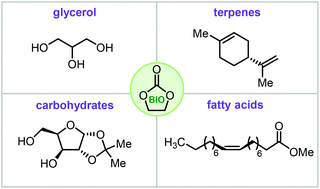
Green Chem., 2021,23, 1077-1113
https://doi.org/10.1039/D0GC03824E
Biological carbon fixation: a thermodynamic perspective
Changes of Gibbs free energy made insights into the carbon fixation pathways from thermodynamic perspective.

Green Chem., 2021,23, 7852-7864
https://doi.org/10.1039/D0GC03493B
Photochemical reduction of carbon dioxide to formic acid
This review presents an overview of the photoreduction of CO2 to formic acid using homogeneous catalysts.

Green Chem., 2021,23, 2553-2574
https://doi.org/10.1039/D0GC04040A
Oxidative dehydrogenation of light alkanes with carbon dioxide
In this critical review, the recent advances of the CO2-assisted catalytic dehydrogenation of light alkanes are summarized.
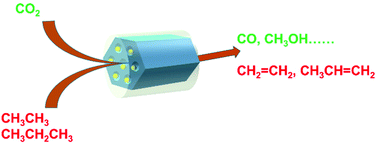
Green Chem., 2021,23, 689-707
https://doi.org/10.1039/D0GC03705B
Recent developments in organocatalysed transformations of epoxides and carbon dioxide into cyclic carbonates
The synthesis of cyclic carbonates from epoxides and carbon dioxide using metal-free catalyst systems is critically reviewed.

Green Chem., 2021,23, 77-118
https://doi.org/10.1039/D0GC03465G
From ‘Gift’ to gift: producing organic solvents from CO2
The latest advances in the field of production of commonly used organic solvents from CO2 are summarized and discussed.
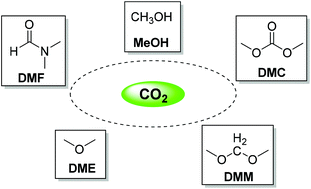
Green Chem., 2020,22, 8169-8182
https://doi.org/10.1039/D0GC03280H
One-step plasma-enabled catalytic carbon dioxide hydrogenation to higher hydrocarbons: significance of catalyst-bed configuration
C2+ hydrocarbons are selectively produced in one-step catalytic CO2 conversion via designing the catalyst-bed configuration under non-thermal DBD plasma operating at low temperature and atmospheric pressure.
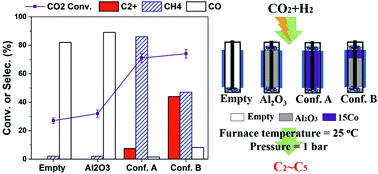
Green Chem., 2021,23, 1642-1647
https://doi.org/10.1039/D0GC03779F
Transition-metal-free synthesis of thiazolidin-2-ones and 1,3-thiazinan-2-ones from arylamines, elemental sulfur and CO2
A multi-component reaction of arylamines, elemental sulfur and CO2 (1 atm) is reported to generate valuable thiazolidin-2-ones and 1,3-thiazinan-2-ones in moderate to good yields under transition-metal-free reaction conditions.

Green Chem., 2021,23, 274-279
https://doi.org/10.1039/D0GC03723K
Rh(I)-Catalyzed regioselective arylcarboxylation of acrylamides with arylboronic acids and CO2
The first Rh(I)-catalyzed regioselective arylcarboxylation of electron-deficient acrylamides with arylboronic acids under atmospheric pressure of CO2 has been developed.
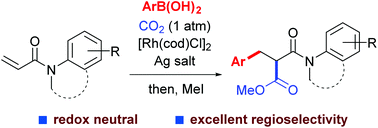
Green Chem., 2020,22, 7328-7332
https://doi.org/10.1039/D0GC02667K
Photoredox-catalyzed dicarbofunctionalization of styrenes with amines and CO2: a convenient access to γ-amino acids
Visible-light-mediated regioselective carbocarboxylation of styrenes using CO2 and amines to generate important γ-amino acids has been realized by photocatalysis.
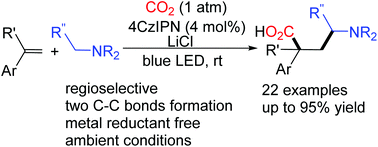
Green Chem., 2020,22, 5961-5965
https://doi.org/10.1039/D0GC02254C
Photothermal CO2 hydrogenation to hydrocarbons over trimetallic Co–Cu–Mn catalysts
Photocatalytic CO2 reduction is a highly vital process for converting CO2 into valuable chemicals.

Green Chem., 2021,23, 5775-5785
https://doi.org/10.1039/D1GC01152A
Electrochemical CO2 reduction on graphdiyne: a DFT study
Graphdiyne exhibits high activity for CO2 electroreduction reaction and the unique sp–sp2 hybridization is crucial.
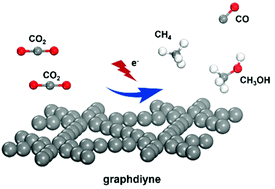
Green Chem., 2021,23, 1212-1219
https://doi.org/10.1039/D0GC03742G
Highly efficient synthesis of alkylidene cyclic carbonates from low concentration CO2 using hydroxyl and azolate dual functionalized ionic liquids
A dual functionalized ionic liquid catalytic system was developed for the reaction between CO2 and propargylic alcohols, and exhibited excellent performance and good reusability, even under a low concentration of CO2 in a gram-scale reaction.
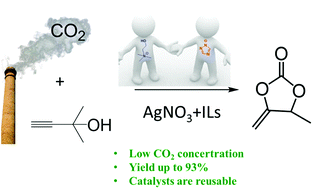
Green Chem., 2021,23, 592-596
https://doi.org/10.1039/D0GC03510F
A self-healing and recyclable polyurethane-urea Diels–Alder adduct synthesized from carbon dioxide and furfuryl amine
A green route to synthesize a self-healing polyurethane-urea Diels–Alder adduct (PUUa-DA) using CO2 and furfuryl amine as renewable feedstocks is reported.
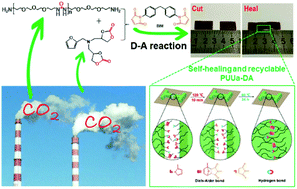
Green Chem., 2021,23, 552-560
https://doi.org/10.1039/D0GC03695A
Molecular H2O promoted catalytic bicarbonate reduction with methanol into formate over Pd0.5Cu0.5/C under mild hydrothermal conditions
Molecular water promoted co-conversion of bicarbonate and methanol into formate over a Pd–Cu catalyst: a H2-free approach for bicarbonate reduction.

Green Chem., 2021,23, 430-439
https://doi.org/10.1039/D0GC02785E
Carbon dioxide derived carbonized polymer dots for multicolor light-emitting diodes
Immobilization of carbon dioxide into fluorescent CPDs is achieved, and multiple-color LEDs are fabricated using the CPDs as single phosphors.
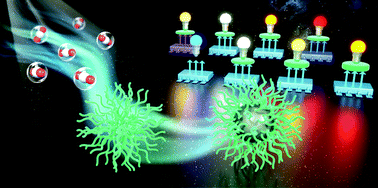
Green Chem., 2021,23, 422-429
https://doi.org/10.1039/D0GC03333B
A rhenium catalyst with bifunctional pyrene groups boosts natural light-driven CO2 reduction
A rhenium–pyrene catalyst that dramatically promotes sunlight-induced CO2RR efficiency was developed by enhancing intermolecular electron transfer efficiency and visible light-harvesting ability.
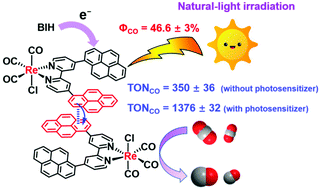
Green Chem., 2020,22, 8614-8622
https://doi.org/10.1039/D0GC03111A
Highly effective capture and subsequent catalytic transformation of low-concentration CO2 by superbasic guanidines
We have developed a novel N,N′-bis(imidazolyl)guanidine-based system, which shows high performance in low-concentration CO2 capture and subsequent catalytic transformation to functionalized (4E,5Z)-4-imino-5-benzylideneoxazolidine-2-ones.
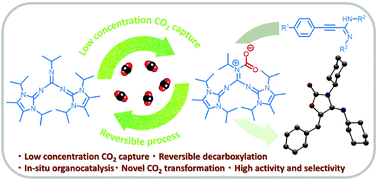
Green Chem., 2020,22, 7832-7838
https://doi.org/10.1039/D0GC03009K
Near neutral waterborne cationic polyurethane from CO2-polyol, a compatible binder to aqueous conducting polyaniline for eco-friendly anti-corrosion purposes
A near-neutral waterborne cationic polyurethane from CO2-polyol was synthesized using BDE as an internal emulsifier. Its compatibility with an aqueous cPANI dispersion and strong adhesion to CS plates mean it could be used for corrosion protection.

Green Chem., 2020,22, 7823-7831
https://doi.org/10.1039/D0GC02592E
Integrating Z-scheme heterojunction of Co1-C3N4@α-Fe2O3 for efficient visible-light-driven photocatalytic CO2 reduction
A direct Z-scheme heterojunction of Co1-C3N4@α-Fe2O3 was constructed for efficient photocatalytic CO2 reduction coupled with water oxidation under visible-light irradiation, with a CO generation rate of 14.9 μmol g−1 h−1 and CO selectivity over 99%.
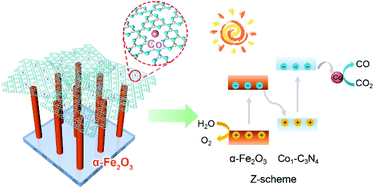
Green Chem., 2020,22, 7552-7559
https://doi.org/10.1039/D0GC02836C
Electrodeposited Cu–Pd bimetallic catalysts for the selective electroreduction of CO2 to ethylene
Cu–Pd bimetallic catalysts were fabricated on carbon paper (CP) by the electrodeposition method via a dynamic hydrogen bubble template approach.

Green Chem., 2020,22, 7560-7565
https://doi.org/10.1039/D0GC03051A
Tuning the coordination number of Fe single atoms for the efficient reduction of CO2
The coordination number of Fe single-atom catalysts (Fe–N5/Fe–N6) significantly affects the electrocatalytic performance during CO2-to-CO conversion.

Green Chem., 2020,22, 7529-7536
https://doi.org/10.1039/D0GC02689A
Tuning selectivity of CO2 hydrogenation by modulating the strong metal–support interaction over Ir/TiO2 catalysts
Modulating the strong metal-support interaction over Ir/TiO2 offers an opportunity for selective transformation of CO2 hydrogenation from CH4 to CO.
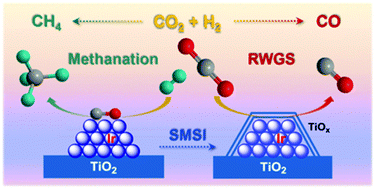
Green Chem., 2020,22, 6855-6861
https://doi.org/10.1039/D0GC02302G
Stabilization of Cu+ by tuning a CuO–CeO2 interface for selective electrochemical CO2 reduction to ethylene
By utilizing the synergistic interaction between CuO and CeO2, the stabilization of Cu+ species at a metal–oxide interface is realized. H2 production is considerably suppressed, resulting in enhanced ethylene production with a high FE of 50.0%.
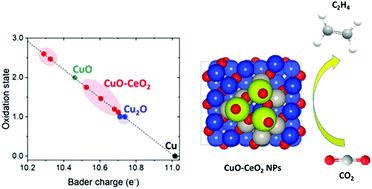
Green Chem., 2020,22, 6540-6546
https://doi.org/10.1039/D0GC02279A
Calix[8]arene-constructed stable polyoxo-titanium clusters for efficient CO2 photoreduction
Self-assembly and CO2 photoreduction performance of two thermodynamically reversibly converted polyoxo-titanium clusters (PTCs), Ti4-C8A and Ti7-C8A, which were modified by calix[8]arene organic “functional armor”.
![Graphical abstract: Calix[8]arene-constructed stable polyoxo-titanium clusters for efficient CO2 photoreduction](/en/Image/Get?imageInfo.ImageType=GA&imageInfo.ImageIdentifier.ManuscriptID=D0GC01497D&imageInfo.ImageIdentifier.Year=2020)
Green Chem., 2020,22, 5325-5332
https://doi.org/10.1039/D0GC01497D
Tetracoordinate borates as catalysts for reductive formylation of amines with carbon dioxide
The first example of borate-catalyzed N-formylation of amines using CO2 as the carbon source in the presence of hydrosilanes is demonstrated using sodium (trihydroxy)phenylborate as a transition metal-free catalyst.

Green Chem., 2020,22, 5317-5324
https://doi.org/10.1039/D0GC01741H
A highly active Pt/In2O3 catalyst for CO2 hydrogenation to methanol with enhanced stability
An In2O3 supported Pt catalyst shows a significantly improved activity towards CO2 hydrogenation with methanol selectivity of ca. 100% at temperatures below 225 °C, 73% at 275 °C and 54% at 300 °C.
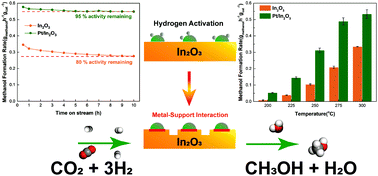
Green Chem., 2020,22, 5059-5066
https://doi.org/10.1039/D0GC01597K
About this collection
As is well known, the massive consumption of fossil fuels, among other human activities, has released substantial amounts of CO2 into the atmosphere, provoking both global warming and dramatic climate changes. As such, carbon dioxide capture and utilisation continues to attract significant attention, and important advances. As an ideal C1 source, efficient transformation of CO2 enables the sustainable synthesis of high value-added chemicals and fuels. Moreover, CO2 can be utilised in a huge number of diverse areas, including as a green tuneable solvent, a working agent, a protective agent, a soft oxidant, and many others. Guest Edited by Professor Liang-Nian He (Nankai University, P. R. China) and Professor Da-Gang Yu (Sichuan University, P. R. China).